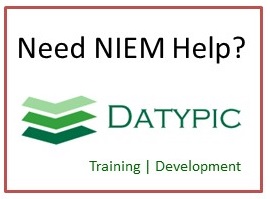gml:Node
gml:Node represents the 0-dimensional primitive. The optional coboundary of a node (gml:directedEdge) is a sequence of directed edges which are incident on this node. Edges emanating from this node appear in the node coboundary with a negative orientation. If provided, the aggregationType attribute shall have the value "sequence". A node may optionally be realised by a 0-dimensional geometric primitive (gml:pointProperty).
Element information
Namespace: http://www.opengis.net/gml/3.2
Schema document: external/ogc/gml/3.2.1/topology.xsd
Type: gml:NodeType
Properties: Global, Qualified
Content
- Sequence [1..1]
- gml:metaDataProperty [0..*] deprecated
- gml:description [0..1] The value of this property is a text description of the object. gml:description uses gml:StringOrRefType as its content model, so it may contain a simple text string content, or carry a reference to an external description. The use of gml:description to reference an external description has been deprecated and replaced by the gml:descriptionReference property.
- gml:descriptionReference [0..1] The value of this property is a remote text description of the object. The xlink:href attribute of the gml:descriptionReference property references the external description.
- gml:identifier [0..1] Often, a special identifier is assigned to an object by the maintaining authority with the intention that it is used in references to the object For such cases, the codeSpace shall be provided. That identifier is usually unique either globally or within an application domain. gml:identifier is a pre-defined property for such identifiers.
- gml:name [0..*] The gml:name property provides a label or identifier for the object, commonly a descriptive name. An object may have several names, typically assigned by different authorities. gml:name uses the gml:CodeType content model. The authority for a name is indicated by the value of its (optional) codeSpace attribute. The name may or may not be unique, as determined by the rules of the organization responsible for the codeSpace. In common usage there will be one name per authority, so a processing application may select the name from its preferred codeSpace.
- gml:container [0..1]
- gml:directedEdge [0..*] In the case of planar topology, a gml:Node must have a clockwise sequence of gml:directedEdge properties, to ensure a lossless topology representation as defined by Kuijpers, et. al. (see OGC 05-102 Topology IPR).
- gml:pointProperty [0..1] This property element either references a point via the XLink-attributes or contains the point element. pointProperty is the predefined property which may be used by GML Application Schemas whenever a GML feature has a property with a value that is substitutable for Point.
from type gml:AbstractGMLTypefrom group gml:StandardObjectProperties
Attributes
| Name | Occ | Type | Description | Notes |
|---|---|---|---|---|
| gml:id | [1..1] | xsd:ID | from type gml:AbstractGMLType | |
| aggregationType | [0..1] | gml:AggregationType | from group gml:AggregationAttributeGroup |
Used in
- Type gml:ArrayAssociationType (Element gml:members)
- Type gml:DirectedNodePropertyType (Element gml:directedNode)
- Type gml:NodeOrEdgePropertyType (Element gml:isolated)
- Type gml:NodePropertyType (Element gml:isolated)
- Type gml:TopoPrimitiveArrayAssociationType (Element gml:topoPrimitiveMembers)
- Type gml:TopoPrimitiveMemberType (Element gml:topoPrimitiveMember)
Substitution hierarchy
- gml:AbstractObject
- can be substituted with gml:AbstractGML
- can be substituted with gml:AbstractTopology
- can be substituted with gml:AbstractTopoPrimitive
- can be substituted with gml:Node
- can be substituted with gml:AbstractTopoPrimitive
- can be substituted with gml:AbstractTopology
- can be substituted with gml:AbstractGML
Sample instance
<gml:Node gml:id="ID"> <gml:metaDataProperty> <gml:GenericMetaData>Any text, intermingled with: <!--any element--> </gml:GenericMetaData> </gml:metaDataProperty> <gml:description>string</gml:description> <gml:descriptionReference/> <gml:identifier codeSpace="http://www.example.com/">string</gml:identifier> <gml:name>string</gml:name> <gml:container> <gml:Face gml:id="ID"> <gml:metaDataProperty>... </gml:metaDataProperty> <gml:description>string</gml:description> <gml:descriptionReference/> <gml:identifier codeSpace="http://www.example.com/">string</gml:identifier> <gml:name>string</gml:name> <gml:isolated>... </gml:isolated> <gml:directedEdge>... </gml:directedEdge> <gml:directedTopoSolid>... </gml:directedTopoSolid> <gml:surfaceProperty>... </gml:surfaceProperty> </gml:Face> </gml:container> <gml:directedEdge> <gml:Edge gml:id="ID"> <gml:metaDataProperty>... </gml:metaDataProperty> <gml:description>string</gml:description> <gml:descriptionReference/> <gml:identifier codeSpace="http://www.example.com/">string</gml:identifier> <gml:name>string</gml:name> <gml:container>... </gml:container> <gml:directedNode>... </gml:directedNode> <gml:directedFace>... </gml:directedFace> <gml:curveProperty>... </gml:curveProperty> </gml:Edge> </gml:directedEdge> <gml:pointProperty> <gml:Point gml:id="ID"> <gml:metaDataProperty>... </gml:metaDataProperty> <gml:description>string</gml:description> <gml:descriptionReference/> <gml:identifier codeSpace="http://www.example.com/">string</gml:identifier> <gml:name>string</gml:name> <gml:pos>1.0 1.0</gml:pos> </gml:Point> </gml:pointProperty> </gml:Node>



